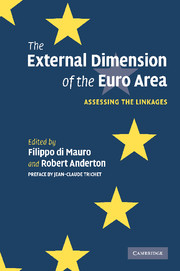Book contents
- Frontmatter
- Contents
- List of illustrations
- List of contributors
- Preface by Jean-Claude Trichet
- 1 Introduction
- 2 The external dimension of the euro area: stylised facts and initial findings
- 3 Product variety and macro trade models: implications for the new EU Member States
- 4 Exchange-rate pass-through to import prices in the euro area
- 5 The international equity holdings of euro area investors
- 6 Global linkages through foreign direct investment
- 7 Shocks and shock absorbers: the international propagation of equity market shocks and the design of appropriate policy responses
- 8 The euro area in the global economy: its sensitivity to the international environment and its influence on global economic developments
- Index
- References
6 - Global linkages through foreign direct investment
Published online by Cambridge University Press: 22 September 2009
- Frontmatter
- Contents
- List of illustrations
- List of contributors
- Preface by Jean-Claude Trichet
- 1 Introduction
- 2 The external dimension of the euro area: stylised facts and initial findings
- 3 Product variety and macro trade models: implications for the new EU Member States
- 4 Exchange-rate pass-through to import prices in the euro area
- 5 The international equity holdings of euro area investors
- 6 Global linkages through foreign direct investment
- 7 Shocks and shock absorbers: the international propagation of equity market shocks and the design of appropriate policy responses
- 8 The euro area in the global economy: its sensitivity to the international environment and its influence on global economic developments
- Index
- References
Summary
Relevance
Over the past decades, national economies have become more integrated through ever-intensifying foreign trade relations and international financial relations (Figure 6.1). For example, cross-border holdings of stocks and bonds have grown spectacularly in the past twenty years due to sharply-lower transaction costs and the worldwide trend towards capital account liberalisation and financial sector deregulation. An important aspect of international economic integration is the larger role of foreign direct investment (FDI) in the economy. FDI has grown at rates far greater than those of international trade or output since the late 1980s, especially among the industrialised countries. Estimates by UNCTAD (2002) put the total stock of FDI capital at 17.5 per cent of global GDP in 2000, more than double the size in 1990 (8.3%). A direct consequence of the greater presence of foreign-owned firms is the internationalisation of production. Currently, about 11 per cent of global production is accounted for by companies that are under control of foreign investors.
The rise in international economic interdependence means that economic conditions in one country have become increasingly sensitive to disturbances occurring in others. The ‘traditional’ channel through which economies may affect each other is formed by international trade flows.
Furthermore, it is widely recognised that the increase in international capital mobility has boosted the importance of financial markets as a conduit for the cross-border transmission of disturbances. Correlations among the major stock markets have greatly increased in the past twenty years (Berben and Jansen 2005).
- Type
- Chapter
- Information
- The External Dimension of the Euro AreaAssessing the Linkages, pp. 118 - 145Publisher: Cambridge University PressPrint publication year: 2007



